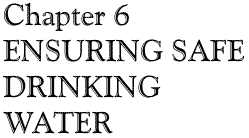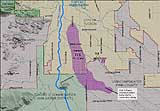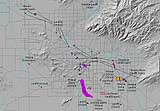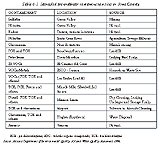|

|
Our health and well being depend upon having a supply of safe drinking water. In much simpler times this might have meant having a good well or a stream nearby. Today the issue is a lot more complex. To supply a large urban population we dip into various water sources: surface water, groundwater and imported water—e.g. CAP water—each with its own water quality concerns. Also we are more aware of different contaminants in water and the need to control or remove them to ensure the safety of our water supply. (If early settlers from those simpler times knew what we know about microbial contaminants they might have been wary of their wells and the nearby streams.) In response to this situation, various water treatment methods have been developed. We are sufficiently privileged that our water quality concerns focus not only on public health matters, but also consider the aesthetic characteristics of our water supply; i.e., its taste and odor.
|
TUCSON WATER QUALITY
For the most part, the quality of the groundwater in the Tucson area is excellent, although problems exist in a few areas. Some water quality problems such as radon and hardness are naturally occurring, but most problems are the result of human activity. In most cases, where pollution occurs, the level is very low and does not constitute a health problem. In seriously contaminated areas, commercial drinking water wells with dangerous levels of contamination are not in use, but private well-owners may still be drawing from contaminated sources. Some of most serious pollution problems have been designated as federal Superfund (CERCLA) or state Water Quality Assurance Revolving Fund (WQARF) sites and some of those problems are being mitigated. The laws and regulations that help protect our water are described in Chapter 7.
GROUNDWATER POLLUTION
TCE Problem

|
| Figure 6-1 Maximum extent of the TCE plume. Sources: Pima County, U.S. Environmental Protection Agency. |
In Tucson a few incidents of health problems have occurred due to water pollution. The best documented incident involves the occurrence of a plume of trichloroethylene (TCE) in groundwater that extends northwest from the Tucson International Airport. In 1981, an unusual cluster of health problems was identified in the area west of the airport. Tests indicated a high level of TCE in the water. Health officials investigated to determine if a connection existed between the polluted water and the reported diseases. They found sufficient evidence to cause Tucson Water to shut down wells in the area and supply residents with water from other parts of the system.

|
| Figure 6-2 Landfills and major identified hazardous plumes in groundwater.Sources: Pima County Department of Environmental Quality, Pima County, Pima Assosiation of Governments. |
Officials then took on the issue of what to do about the contaminated area. They first had to determine who was responsible for the cleanup and what methods were best to use. Most of the aircraft companies responsible for the problem had ceased operations years earlier. Ultimately, Hughes Aircraft (since purchased by Raytheon) built a treatment plant to deal with the problem beneath its property. As a result of a consent decree and agreement, the Tucson Airport Authority, U.S. Air Force and others built a treatment plant for the water downgrade from the airport. Operated by Tucson Water, the Tucson Airport Remediation Project (TARP) is located on the east side of the Santa Cruz River near Irvington Road. Nine extraction wells and five miles of transmission mains transport water to the plant. TARP has three 35-foot air-stripping towers with air emission controls that remove the volatile compounds to avoid air pollution problems. The plant also disinfects the water and adjusts its pH
. Treated water is
tested weekly, and no detectable amounts of TCE have been found. TARP costs $780,000 annually to operate. Raytheon, U.S. Air Force, McDonnell Douglas Corp. and the Tucson Airport Authority pay the cost of operating the facility.
TESTING FOR POLLUTANTS
Testing for a full range of pollutants is costly because different pollutants must be tested by different methods, and the amount of pollutant to be detected is generally very small, perhaps as little as one part pollutant in a billion parts water. Routine water testing is generally conducted for common pollutants such as coliform bacteria, nitrogen or sulfur compounds. Where reasons exist to suspect other pollutants such as TCE, tests for those pollutants become part of the testing routine. There are now well over 230 priority pollutants for which water supplies must be tested at least once a year. Standardized testing is unavailable for many uncommon potential pollutants.
|

|
| Table 6-1 Identified groundwater contamination sites in Pima County. |
Officials also had to decide what to do with the treated water. Under a Consent Agreement, approved by EPA, Tucson Water blends the treated water with other water and distributes it in the city water system. The treated water currently goes to customers downtown, and the near northwest side. Although this water meets all EPA drinking water standards, some customers objected to its use. In 1995, when voters approved the Water Consumer Protection Act to limit the city’s use of CAP water, they also restricted the city’s use of this treated water since it originated from a “polluted source.” Tucson Water, however, still must meet the conditions of the legally binding EPA consent agreement and continues to put the treated water into the municipal system until a solution is worked out.
|




